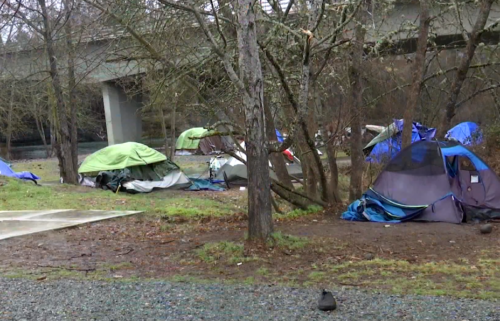As water allocations fall amid severe drought, struggling C.O. farmers search for answers
Amid challenges to growing traditional amount crops, they seek state changes in how water is allocated
MADRAS, Ore. (KTVZ) -- Casad Family Farms manages 360 acres of land in Jefferson County, growing a variety of crops and animals. Operators Cate Havstad-Casad and Chris Casad said Tuesday that amid another year of serious drought, they are receiving less than 20 percent of their normal water allotment this year.
In a normal year, their allocation has been 2 1/2 acre feet of water, which would allow them to continue their normal operations. But since 2017, their water allocation has been declining. Now, they have to cut out most of their staple crop, potatoes, to continue their operation.
They said the low water distribution is devastating several of the local farmers and, to little surprise, their businesses.
“The fact that we won’t be able to grow for the people of Central Oregon this year because of the misallocation of water has significant impacts on all of the families we feed, all of the restaurants we sell to, all the grocery stores we sell to," Havstad-Casad said. "We also won’t be able to sell our organic hay, so all the other farmers and animal owners who rely on our hay -- we won’t be able to sell them hay this year.”
A large number of Jefferson County residents rely on agriculture to survive and, without access to more water, people can’t sustain a living.
“The way that water allocation works in the state of Oregon is founded upon the doctrine of prior appropriation, which means there’s a level of seniority,” Havstad-Casad said. “The most senior districts will get allotted first, and when things are scarce, the most junior holders will be cut first.”
Havstad-Casad said the big problem is how irrigation water is applied.
“Water that is watering someone’s lawn or is watering a golf course, or going into a recreational lake for somebody to ski on, is weighed equivalently to the water we would apply for farming, in order to grow food.”
In short, she said, water is going to non-agricultural uses while the farms go dry.
The North Unit Irrigation District is the largest in Central Oregon, with some of the most junior water rights.
Havstad-Casad said the effects of the unfolding war in Ukraine are adding to the pressure on agriculture here. With Russia being one of the largest producers of fertilizer, she said, it’s getting harder for farmers to get access to it. The compounded pressures of the larger global crisis and the way water is allocated in Central Oregon, she said, is creating a negative ripple effect.
Megan Kellner-Rode is another farmer affected by the water issues. She co-owns Boundless Farmstead with her husband, David Kellner-Rode. They tend to a 20-acre property in Alfalfa, east of Bend.
She told NewsChannel 21 that she has reached out to dozens of legislators and lobbyists to ask that they review, redefine and reconfigure irrigation and water laws, rules, and regulations in Oregon. However, she has not received a response from any of the agencies yet.
She said her detailed letter sent last month was intended to define, explain and examine some of the issues with Oregon water laws.
In order for the farmers to preserve their way of life and feed many people, they hope to get action from legislators soon.




